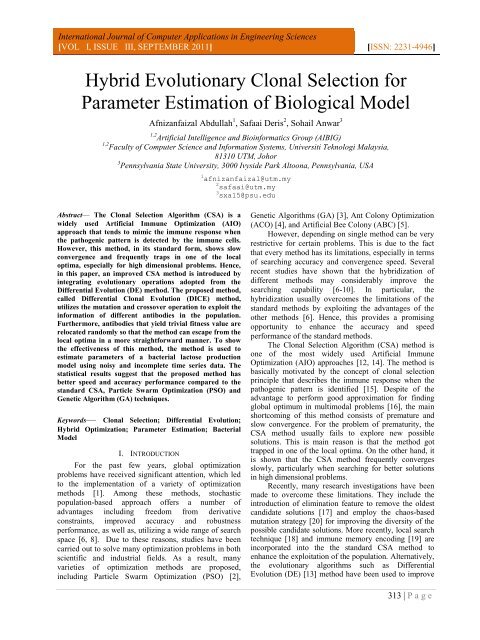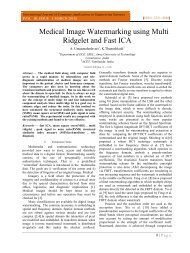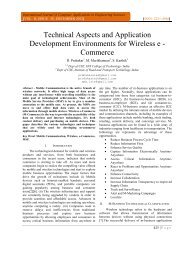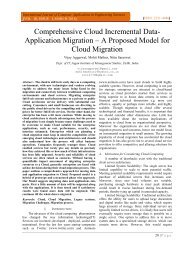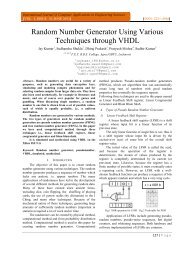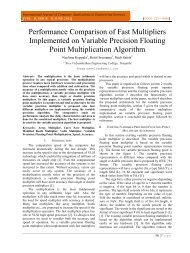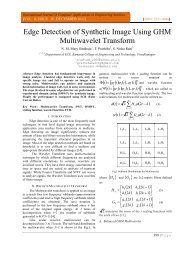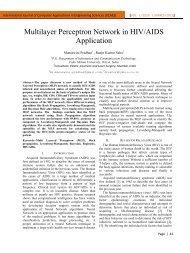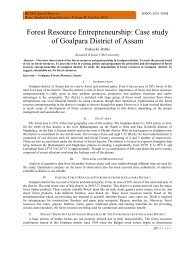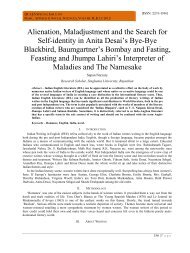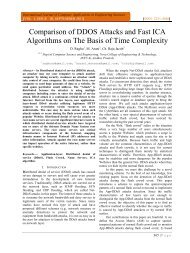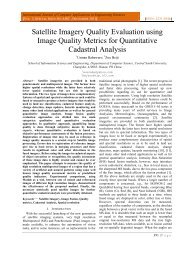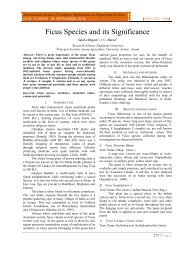IEEE Paper Template in A4 (V1) - International Journal of Computer ...
IEEE Paper Template in A4 (V1) - International Journal of Computer ...
IEEE Paper Template in A4 (V1) - International Journal of Computer ...
You also want an ePaper? Increase the reach of your titles
YUMPU automatically turns print PDFs into web optimized ePapers that Google loves.
Abdullah et. al.the search<strong>in</strong>g capability <strong>of</strong> the CSA method. Theevolutionary operations <strong>of</strong> the DE method are commonlyutilized to enhance the proliferation process <strong>in</strong> the CSAmethod, thereby substantially utiliz<strong>in</strong>g the <strong>in</strong>formationregard<strong>in</strong>g the adjo<strong>in</strong><strong>in</strong>g clones [15-16].In this work, the research that is relevant to theimprovement <strong>of</strong> the search<strong>in</strong>g capability <strong>of</strong> standardCSA method is extended by us<strong>in</strong>g the evolutionaryoperations <strong>of</strong> DE method. In this variant <strong>of</strong> the CSAmethod, the crossover and mutation operation areimplemented to exploit the <strong>in</strong>formation regard<strong>in</strong>gdifferent antibodies <strong>in</strong> the population. Simultaneously,the antibodies provid<strong>in</strong>g <strong>in</strong>significant solutions arerelocated randomly to enhance the fitness values. Bydo<strong>in</strong>g so, the method can efficiently improve thesearch<strong>in</strong>g quality as well as utiliz<strong>in</strong>g the computationaltime. The effectiveness <strong>of</strong> the proposed method is testedto estimate parameter values <strong>in</strong> a biological model andthe statistical results are then compared with thestandard CSA, PSO and GA methods. The rest <strong>of</strong> thepaper is organized as follows. Sections II <strong>in</strong>troduce thestandard CSA, standard DE methods, and the proposedDifferential Clonal Evolution (DICE) method.Subsequently, Section III presents the experimentalresults. Section IV discusses the contribution <strong>of</strong> thework and Section V presents the conclusion and futureworks.II. METHODSA. Standard Clonal Selection Algorithm (CSA) MethodThe clonal selection pr<strong>in</strong>ciple [21] describes thereaction <strong>of</strong> immune system to pathogens and the process<strong>of</strong> improv<strong>in</strong>g the capability to identify these un<strong>in</strong>tendedagents. In particular, the theory illustrates that a number<strong>of</strong> immune cells that identify the pathogens willproliferate. Some <strong>of</strong> them will become the effector cellswhile the others ma<strong>in</strong>ta<strong>in</strong> their role as memory cells [18].In general, the CSA method employs three ma<strong>in</strong> phases:clon<strong>in</strong>g, mutation and selection. The method starts witha population <strong>of</strong> d-dimensional search vectors, calledantibodies. The ith antibody, X, <strong>of</strong> the whole populationat a specific generation t is given by:In CSA method, the fitness value <strong>of</strong> each antigen isrepresented as aff<strong>in</strong>ity, which implies the goodness <strong>of</strong> theantibody to generate antigen for the specific pathogen.Initially, the population <strong>of</strong> antibody is <strong>in</strong>itiatedrandomly and the aff<strong>in</strong>ity <strong>of</strong> each antibody is evaluated.The antibodies that produce good aff<strong>in</strong>ity values areselected to undergo clon<strong>in</strong>g phase. As a result, a new set<strong>of</strong> population is created. Next, the mutation process is(1)performed to every clone, based on the mutationconstant. Hence, the mutated clones are formed withnew components and the aff<strong>in</strong>ity values are then beenevaluated to measure the fitness. In the last phase, themutated clones are selected to replace the orig<strong>in</strong>alantibodies. Eventually, the population is built with thenew improved antibodies. The overall procedure <strong>of</strong> thestandard CSA method is outl<strong>in</strong>ed <strong>in</strong> Figure 1:1: Beg<strong>in</strong>2: Initiate population, X3: // evaluate fitness <strong>of</strong> each antibody4: While max number <strong>of</strong> generation is not met5: // Select m best antibodies6: For i = 1 to m antibody7: // clon<strong>in</strong>g selected antibodies8: // mutate clones9: // select improved clones to10: replace old antibodies11: End For12: //<strong>in</strong>clude improved best13: antibodies to population14: End While15: End Beg<strong>in</strong>Fig. 1. The standard CSAB. Standard Differential Evolution (DE) MethodThe DE method is also a stochastic populationbasedoptimization method. The method is proposedbased on the evolutionary operations <strong>of</strong> the GA method[13]. Compare to GA, this method employs a mutationoperation to produce a trivial chromosome from theorig<strong>in</strong>al chromosome. Then, this trivial chromosome iscrossovered with its orig<strong>in</strong>al counterpart to generate an<strong>of</strong>fspr<strong>in</strong>g chromosome. A simple selection operation isperformed to select the chromosome with a better fitnessvalue. In each generation, a range <strong>of</strong> search space isspecified to f<strong>in</strong>d a good solution. Thus, at <strong>in</strong>itialgeneration or t = 0, each chromosome is <strong>in</strong>itialized, witha lower and an upper bound, and respectively [13]:where R is a random number generated between 0 and 1and j is the dimension size.In order to produce the trivial chromosome, V i , themutation operation is executed accord<strong>in</strong>g to thedifferentiation <strong>of</strong> neighborhood chromosomes, given asfollow<strong>in</strong>g:(3)where x best(t) denotes the current best chromosome, F isthe scal<strong>in</strong>g factor, while x r1(t) and x r2(t) are randomlychosen chromosomes [13]. Us<strong>in</strong>g this chromosome, an(2)314 | P a g e
Abdullah et. al.Mackey [22] <strong>in</strong>troduced a mathematical model for theregulation <strong>of</strong> <strong>in</strong>duction process <strong>in</strong> the lac operon thatconsidered the dynamics <strong>of</strong> the permease enabl<strong>in</strong>g the<strong>in</strong>ternalization <strong>of</strong> several biomolecules such as lactoseand β-galactosidase. The model is important for theobservation <strong>of</strong> the conversion <strong>of</strong> lactose to allolactose,glucose and galactose; the allolactose <strong>in</strong>teractions withthe lac repressor; and the mRNA [22]. The model isformed through the follow<strong>in</strong>g equations:where A, B and L are the concentrations <strong>of</strong> allolactose, β-galactosidase and lactose, respectively; M is the mRNAtranslation; is time; , and are the productionrate constants; and are the loss rate constants; isthe dilution rate constant; and are the equilibriumconstants <strong>of</strong> allolactose and lactose, respectively [22].Thus, <strong>in</strong> this work, the values <strong>of</strong> , , , , ,and parameters are tended to be estimated. Theexperimental values <strong>of</strong> these parameters are given <strong>in</strong>Table 1 [22].TABLE IEXPERIMENTAL VALUES OF THE REGULATION MODELParameterExperimental Value1.76 × 10 4 m<strong>in</strong> -11.66 × 10 -2 m<strong>in</strong> -12.15 × 10 4 m<strong>in</strong> -15.20 × 10 -1 m<strong>in</strong> -18.33 × 10 -4 m<strong>in</strong> -12.26 × 10 -2 m<strong>in</strong> -11.95 × 10 -3 M9.70 × 10 -4 MIn this work, the experimental data is obta<strong>in</strong>ed <strong>in</strong>silico by generat<strong>in</strong>g noisy and sparse version <strong>of</strong> themodel data. Firstly, the model is simulated and the valuesat several randomly chosen time po<strong>in</strong>ts are evaluated.Then, the Gaussian noise is added to the values so that itwill simulate the measurement noise [23]. The modeldata and the generated noisy and sparse experimentaldata <strong>of</strong> β-galactosidase and allolactose are illustrated <strong>in</strong>Figure 3 and Figure 4, respectively.B. Parameter EstimationGenerally, the parameter estimation problem isformulated <strong>in</strong> the follow<strong>in</strong>g way. Suppose that a systemis formed by the d-dimensional state variable, x, at time t,which is the dist<strong>in</strong>ctive solution <strong>of</strong> the <strong>in</strong>itial valueproblem:(6)(7)where p is the parameters [24]. So, let y signify theobservation <strong>of</strong> experimental value, i, correspond<strong>in</strong>g tothe measurement, j, and represented by the follow<strong>in</strong>gequation:where σ ij > 0 and ɛ ij is a Gaussian distributed randomvariable [24]. Thus, the parameter estimation problem <strong>of</strong>a biological system consists <strong>of</strong> f<strong>in</strong>d<strong>in</strong>g the optimalparameter p such that the difference <strong>of</strong> the experimentaldata and the simulated data is m<strong>in</strong>imized:(8)(9)(10)where is the trajectory at time t, n is the totalnumber <strong>of</strong> parameters and m is the total number <strong>of</strong>observed values [24].The results obta<strong>in</strong>ed from the proposed method arecompared with those from the standard CSA, PSO andGA methods. For each method, a population size <strong>of</strong> 50particles or chromosomes is <strong>in</strong>itiated and the maximumnumber <strong>of</strong> generations is set to 200. Furthermore, eachmethod is executed 100 times <strong>in</strong>dependently to observeits reliability and consistency. Table 2 shows the averagefitness values and the correspond<strong>in</strong>g standard deviationfor each method. In general, the proposed DICE methodhas outperformed the standard methods. Hence, theaccuracy <strong>of</strong> the proposed method is better compared tothe other methods, as the overall fitness value obta<strong>in</strong>ed isthe lowest among those from the other methods.TABLE IIACCURACY AND SPEED PERFORMANCEMethod GA PSO CSA DICEAverage 3.72×10 -3 3.56×10 -3 4.64×10 -4 1.93×10 -9StandardDeviationAverageSpeed(second)3.07×10 -3 3.00×10 -3 7.94×10 -4 4.15×10 -90.358 6.240 0.483 0.452316 | P a g e
Hybrid Evolutionary Clonal Selection for Parameter Estimation <strong>of</strong> Biological ModelFig. 3. Comparison <strong>of</strong> the model data and the experimental data for concentration <strong>of</strong> β-galactosidaseFig. 4. Comparison <strong>of</strong> the model data and the experimental data concentration <strong>of</strong> allolactoseTo address the performance <strong>of</strong> the proposedmethod <strong>in</strong> terms <strong>of</strong> convergence speed, Figure 5illustrates the graph <strong>of</strong> convergence for all methods.Obviously, the standard GA and PSO methodsconverged prematurely while the standard CSA methodsuccessfully f<strong>in</strong>ds better fitness values compared to theGA and PSO methods. However, the method waseventually trapped <strong>in</strong> one <strong>of</strong> the local optima start<strong>in</strong>g atthe 165th generation. This problem has been effectivelysolved by the proposed method as the values are keptdecreas<strong>in</strong>g until the maximum number <strong>of</strong> generations isreached.In addition, a statistical analysis <strong>of</strong> the observedmeasurements and the fitted data produced by theproposed DICE method is conducted. In this analysis,confidence <strong>in</strong>terval estimates us<strong>in</strong>g chi-squared (χ 2 )distribution is used. The result <strong>of</strong> this analysis ispresented <strong>in</strong> Table 3. The result shows that the proposedmethod is reliable for the estimation <strong>of</strong> the parametervalues as the mean error is substantially small for bothcomponents <strong>of</strong> the model. Moreover, the variance po<strong>in</strong>tlies between the <strong>in</strong>terval estimates. Thus it is confirmedthat the estimate obta<strong>in</strong>ed us<strong>in</strong>g the DICE method canbe generally considered as valid.317 | P a g e
Abdullah et. al.Fig. 5. Convergence behaviours <strong>of</strong> each methodParameter estimation <strong>of</strong> complex biological modelsis usually presented as an optimization problem [23, 24].The approximation <strong>of</strong> the parameter values is alwaysh<strong>in</strong>dered by the noise and <strong>in</strong>completeness <strong>of</strong> theexperimental data. Thus, optimization methods such asthe GA and PSO methods have always been consideredfor this problem because they are capable <strong>of</strong> fitt<strong>in</strong>g theexperimental data with the model prediction effectively.However, a substantial number <strong>of</strong> studies have shownthat these methods are frequently trapped <strong>in</strong> one <strong>of</strong> thelocal optima [6]. Moreover, these methods always<strong>in</strong>volve a huge search space that requires a large amount<strong>of</strong> computational time. Hence, a significant number <strong>of</strong>studies have been conducted to merge several methods toovercome this challenge [6-11]. Nevertheless, thisapproach shows potential <strong>in</strong> improv<strong>in</strong>g the accuracy andspeed <strong>of</strong> the standard methods.TABLE IIISTATISTICAL ANALYSIS OF FITTED DATA BY DICE METHODComponent β-galactosidase AllolactoseError 0.21% 0.40%Variance Po<strong>in</strong>t 4.65×10 -8 2.49×10 -1Variance Interval [3.74×10 -8 ,[2.00×10 -1 ,3.35×10 -1 ]6.26×10 -8 ]Real Variance 4.64×10 -8 2.48×10 -1χ 2 TestPassIV. DISCUSSIONIn this work, the proposed DICE method haspresented another prospective alternative for enhanc<strong>in</strong>gthe quality <strong>of</strong> the parameter estimation results. As shown<strong>in</strong> Table 2, the method has outperformed all thecompetitive methods efficiently, <strong>in</strong> terms <strong>of</strong> both,accuracy and speed performance. The accuracyperformance <strong>of</strong> the proposed DICE method has shownremarkable improvement compared to the resultsproduced by the other methods. This is because <strong>of</strong> thetwo ma<strong>in</strong> reasons. Firstly, the DICE method employsevolutionary operations to the antibodies that yieldpotentially good fitness values. As the operations areperformed to these antibodies, the fitness values areimproved significantly at each generation as the<strong>in</strong>formation regard<strong>in</strong>g different antibodies is utilized toproduce more significant fitness values. Secondly, theantibodies that produced <strong>in</strong>significant fitness values aresubjected to undergo randomization operation. By do<strong>in</strong>gso, the method can enhance the fitness values <strong>of</strong> theseantibodies, thus allow<strong>in</strong>g the method to escape the localoptima more effectively. This is shown by theconvergence behavior <strong>of</strong> the DICE method <strong>in</strong> Figure 4.Nonetheless, there is only a small difference <strong>of</strong>speed performance between the proposed method and itsstandard counterpart. This is due to the fact that theproposed method uses the computational timeextensively for each antibody to exchange <strong>in</strong>formationbetween its neighbors. Even though f<strong>in</strong>d<strong>in</strong>g the possiblebest values can be achieved more effectively, thisrequires numerous runtimes to execute the evolutionaryoperation on every antibody <strong>in</strong> the population. Hence, thescalability <strong>of</strong> the problem dimension may affect thespeed performance <strong>of</strong> the method. However, statisticalanalysis performed on the results produced by theproposed DICE method show that the method is capable<strong>of</strong> estimat<strong>in</strong>g the parameter values accurately. Themethod passed the χ2 test, <strong>in</strong>dicat<strong>in</strong>g that the valuesestimated by the proposed method are very close to theactual values.V. CONCLUSIONGlobal optimization problems present a majorchallenge <strong>in</strong> both scientific and <strong>in</strong>dustrial fields. Thus, asignificant number <strong>of</strong> optimization methods have been318 | P a g e
Hybrid Evolutionary Clonal Selection for Parameter Estimation <strong>of</strong> Biological Modeldeveloped to overcome these problems. In most cases,global optimization methods are always chosen due tothe capability to handle nonl<strong>in</strong>earity <strong>of</strong> the problems.However, these methods are usually hampered by somelimitations <strong>in</strong>clud<strong>in</strong>g huge computational timeconsumption and gett<strong>in</strong>g stuck <strong>in</strong> one <strong>of</strong> the local optima.This led to the development <strong>of</strong> hybrid optimizationmethods, which ma<strong>in</strong>ly tends to comb<strong>in</strong>e severaldifferent methods to improve the limitations by utiliz<strong>in</strong>gthe advantages <strong>of</strong> the comb<strong>in</strong>ed methods.This paper presented a new hybrid optimizationmethod based on the CSA method and the evolutionaryoperations adopted from the DE method. Theeffectiveness <strong>of</strong> the new method is tested us<strong>in</strong>g noisy and<strong>in</strong>complete experimental data <strong>of</strong> a bacterial lactoseproduction model. The results are compared to thestandard CSA, PSO and GA methods. The comparisonsuggests that the accuracy and the speed performance <strong>of</strong>the proposed method are better than that can be obta<strong>in</strong>edfrom other methods. Despite <strong>of</strong> this achievement, thereare several limitations which need to be addressed. Thecomputational time constitutes one such limitation.Hence, research is needed to overcome this challenge.The future research work may <strong>in</strong>volve the improvement<strong>of</strong> the proposed DICE method through a use <strong>of</strong> localoptimization approach and adaptive features. In addition,this study only considered one nonl<strong>in</strong>ear model, whichmay ponder the restriction <strong>of</strong> the actual performance <strong>of</strong>the proposed method. Therefore, <strong>in</strong> the future, theperformance <strong>of</strong> the method will be verified by us<strong>in</strong>g anumber <strong>of</strong> different models to show the reliability androbustness <strong>of</strong> the method.REFERENCES[1] N. Noman and H. Iba, ―Accelerat<strong>in</strong>g differential evolutionus<strong>in</strong>g an adaptive local search,‖ <strong>IEEE</strong> Transactions onEvolutionary Computation, pp.107-125, volume 12, no. 1, 2008.[2] J. Kennedy and R. Eberhart, ―Particle swarm optimization,‖ <strong>in</strong>Proc. <strong>IEEE</strong> <strong>International</strong> Conference on Neural Networks,1995, pp.1942-1948.[3] D.E. Goldberg and J.H. Holland, ―Genetic algorithms andmach<strong>in</strong>e learn<strong>in</strong>g‖, Mach<strong>in</strong>e Learn<strong>in</strong>g, pp. 95-99, volume 3, no.2, 1988.[4] M. Dorigo and G. Di Caro,"The ant colony optimization metaheuristic,"New ideas <strong>in</strong> optimization, pp.11-32, 1999.[5] D. Karaboga and B. Basturk, "A powerful and efficientalgorithm for numerical function optimization: artificial beecolony (ABC) algorithm," <strong>Journal</strong> <strong>of</strong> Global Optimization,pp.459-471, volume 39, no. 3, 2007.[6] S. Das, A. Abraham and A. Konar, ―Particle swarmoptimization and differential evolution algorithms: technicalanalysis, applications and hybridization perspective,‖ Studies <strong>in</strong>Computational Intelligence, pp. 1-38, 2008.[7] P. Kaelo and M.M. Ali, ―Differential evolution algorithms us<strong>in</strong>ghybrid mutation,‖ Computational Optimization Application, pp.231-246, volume 37, no.2, 2007.[8] S. Das, P. Koduru, M. Gui, M. Cochran, A. Ware<strong>in</strong>g, S.M.Welch and B.R. Rab<strong>in</strong>, ―Add<strong>in</strong>g local search to particle swarmoptimization,‖ <strong>in</strong> Proc. <strong>in</strong> <strong>IEEE</strong> Congress on EvolutionaryComputation, 2006, pp. 428-433.[9] C. Zhang, J. N<strong>in</strong>g, S. Lu, D. Ouyang and T. D<strong>in</strong>g, ―A novelhybrid differential evolution and particle swarm optimizationalgorithm for unconstra<strong>in</strong>ed optimization,‖ OperationalResearch Letters, pp. 117-122, volume 37, 2009.[10] Z.H. Zhan, J. Zhang, Y. Li, H.S.H. Chung, ―Adaptive ParticleSwarm Optimization,‖ <strong>IEEE</strong> Trans. Syst. Man Cybr., pp.1362-1381, volume 39, no.6, 2009.[11] W. Fu, M. Johnston, M. Zhang, ―Hybrid particle swarmoptimization algorithms based on differential evolution andlocal search,‖ AI 2010:Adv. Artif. Intel., pp.313-322, 2010[12] L.N. De Castro and F.J. Von Zuben, ―The clonal selectionalgorithm with eng<strong>in</strong>eer<strong>in</strong>g applications,‖ <strong>in</strong> Proc. <strong>of</strong>GECCO'00, workshop on artificial immune systems and theirapplications, volume 3637, 2000, pp. 36-37.[13] R. Storn and K. Price, "Differential evolution—a simple andefficient heuristic for global optimization over cont<strong>in</strong>uousspaces." J. Glob. Optim, pp.341–359 , volume 11, 1997.[14] L.N.de Castro, F.J.von Zuben, ―Learn<strong>in</strong>g and optimizationus<strong>in</strong>g the clonal selection pr<strong>in</strong>ciple,‖ <strong>IEEE</strong> Transactions onEvolutionary Computation, pp.239–251, volume 6, no. 3, 2002.[15] X.Z. Gao, X. Wang and S.J. Ovaska, ―Fusion <strong>of</strong> clonal selectionalgorithm and differential evolution method <strong>in</strong> tra<strong>in</strong><strong>in</strong>g cascadecorrelationneural network,‖ Neurocomput<strong>in</strong>g, pp. 2483-2490,volume 72, no. 10-12, 2009,[16] M. Gong, L. Zhang, L. Jiao and W. Ma, ―Differential immuneclonal selection algorithm,‖ Int. Symp. on Intelligent SignalProcess<strong>in</strong>g and Communication Systems (ISPACS 2007), 2007,pp.666-669.[17] V. Cutello, G. Nicosia and M. Pavone, ―Real coded clonalselection algorithm for unconstra<strong>in</strong>ed global optimization us<strong>in</strong>ga hybrid <strong>in</strong>versely proportional hypermutation operator,‖ <strong>in</strong>Proc. ACM symposium on Applied comput<strong>in</strong>g, 2006, pp. 950-954[18] J. Yang, M. Gong, L. Jiao and Zhang, ―Improved clonalselection algorithm based on lamarckian local search technique,‖<strong>IEEE</strong> Congress on Evolutionary Computation (CEC 2008),2008,pp.535-541[19] W. Dong, G. Shi and L. Zhang, ―Immune memory clonalselection algorithms for design<strong>in</strong>g stack filters,‖Neurocomput<strong>in</strong>g, pp.777-784, volume 70, no. 4-6, 2007.[20] M. Gong, L. Jiao, L. Zhang and W. Ma, ―Improved real-valuedclonal selection algorithm based on a novel mutation method,‖Int. Symp. on Intelligent Signal Process<strong>in</strong>g and CommunicationSystems (ISPACS 2007), 2007, pp. 662-665.[21] G.L. Ada and G.J.V. Nossal, ―The Clonal Selection Theory,‖Scientific American, pp. 50-57, volume 257, no. 2, 1987.[22] N. Yildirim and M.C. Mackey, ―Feedback regulation <strong>in</strong> thelactose operon: a mathematical model<strong>in</strong>g study and comparisonwith experimental data,‖ Biophysical <strong>Journal</strong>, pp.2841-2851,volume 84, no. 5, 2003.[23] G. Lillacci and M. Khammash, "Parameter estimation andmodel selection <strong>in</strong> computational biology," PLoSComputational Biology, e1000696, volume 6, no.3, 2010.[24] E. Balsa-Canto, M, Peifer, J.R. Banga, J. Timmer and C. Fleck:,―Hybrid optimization method with general switch<strong>in</strong>g strategyfor parameter estimation, ― BMC Systems Biology, pp.26-35,volume 2, no. 1, 2008.319 | P a g e


